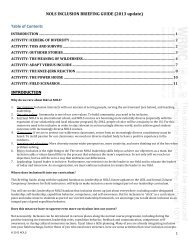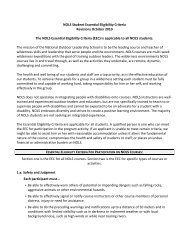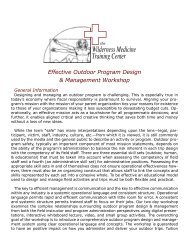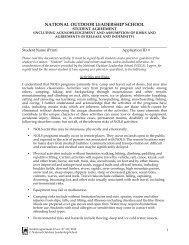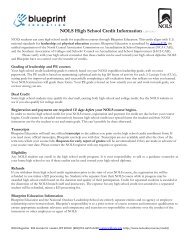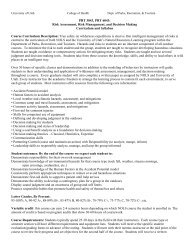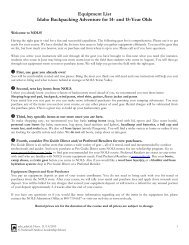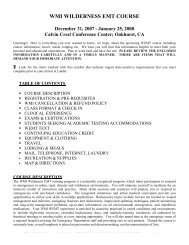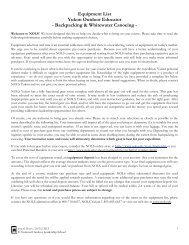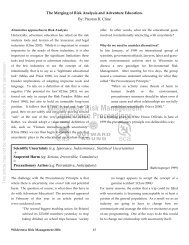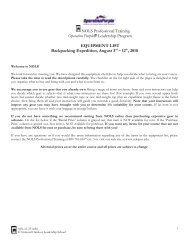introduction to the 2008 nols leadership educator notebook
introduction to the 2008 nols leadership educator notebook
introduction to the 2008 nols leadership educator notebook
You also want an ePaper? Increase the reach of your titles
YUMPU automatically turns print PDFs into web optimized ePapers that Google loves.
LEADERSHIP EDUCATION AT NOLSHISTORICAL BACKGROUNDPaul Petzoldt, founder of <strong>the</strong> National Outdoor LeadershipSchool (NOLS), recognized that <strong>the</strong> wilderness itself teaches <strong>leadership</strong>.Petzoldt saw that in <strong>the</strong> wild, people learn <strong>to</strong> master whatthings <strong>the</strong>y can control, and <strong>the</strong>y learn <strong>to</strong> live in rhythm with <strong>the</strong>things <strong>the</strong>y cannot.Petzoldt passionately believed that NOLS must teach <strong>leadership</strong>using real experiences. Upon starting <strong>the</strong> school he said, “We have<strong>to</strong> have something that is real: like climbing mountains, like fordingwild rivers, like exploring wild country, like facing <strong>the</strong> s<strong>to</strong>rms, likesurviving in <strong>the</strong> wilderness.” With clear and tangible course goals,instruc<strong>to</strong>rs create <strong>the</strong>se real experiences that are <strong>the</strong> foundation ofNOLS’ <strong>leadership</strong> education.Natural ConsequencesIn <strong>the</strong> wilderness, physical feedback from decisions or actions isoften immediate, sometimes raw, and usually quite accurate. Sometimesfeedback takes <strong>the</strong> form of an uncomfortable night becausestudents didn’t look after <strong>the</strong>ir equipment in <strong>the</strong> rain. Sometimesit’s a feeling of uncommon unity after <strong>the</strong>y work <strong>to</strong>ge<strong>the</strong>r <strong>to</strong> travelthrough thigh-deep snow.Experience alone, however, does not evoke better <strong>leadership</strong>. Petzoldtsaid, “All my life I have had <strong>to</strong> fight against <strong>the</strong> myth, <strong>the</strong> oldwives tale, that you develop judgment from experience. A personcan be in <strong>the</strong> outdoors for years and repeat <strong>the</strong> same mistakes timeafter time.”ReflectionFor raw experience <strong>to</strong> ripen in<strong>to</strong> <strong>leadership</strong> growth, our studentsmust understand and learn from <strong>the</strong> consequences of <strong>the</strong>ir actions.It is critical that <strong>the</strong>y reflect upon and discuss <strong>the</strong>ir experiences sothat <strong>the</strong>y may determine what <strong>to</strong> repeat and what <strong>to</strong> change. Theymust practice and expand <strong>the</strong>ir <strong>leadership</strong> skills.Character EducationThe character of a group’s leaders and members will ei<strong>the</strong>r aidit in, or prevent it from, accomplishing its goals. Individuals need<strong>to</strong> develop <strong>the</strong>ir own character by applying values, not just talkingabout <strong>the</strong>m. True character is walking <strong>the</strong> walk. Pla<strong>to</strong> said, “We obtainbetter knowledge of a person during one hour’s play and gamesthan by conversing with <strong>the</strong>m for a whole year.” We teach characterwhen we teach Expedition Behavior. This book also addresses characterin <strong>the</strong> section “The Waterline Model”.Role of NOLS Instruc<strong>to</strong>rsNOLS instruc<strong>to</strong>rs are guardians of <strong>the</strong> <strong>leadership</strong> learning processand teachers of new skills and knowledge. They create an environmentthat allows learning <strong>to</strong> happen naturally and safely. Theydon’t teach people a different way of being, <strong>the</strong>y create conditionssuch that students can discover <strong>the</strong>ir own natural <strong>leadership</strong>.TransferenceStudents at NOLS learn <strong>to</strong> appreciate things that many peopletry <strong>to</strong> avoid but which are necessary if <strong>the</strong>y are <strong>to</strong> lead: <strong>to</strong>lerance forambiguity and <strong>the</strong> unknown, <strong>to</strong>lerance for daunting challenge, <strong>to</strong>lerancefor <strong>the</strong>ir own and o<strong>the</strong>rs’ anxiety, <strong>to</strong>lerance for disapproval,<strong>to</strong>lerance for hard physical work and discomfort, and <strong>to</strong>lerance for<strong>the</strong>ir shared humanity. They experience <strong>the</strong> joy of meeting a challengewell, of creating a vibrant community, of living and travelingin <strong>the</strong> wild, and of appreciating and protecting <strong>the</strong> natural worldaround <strong>the</strong>m.Leadership skills learned at NOLS are life skills. The increasedself-assessment, competence, communication, expedition behavior,decision-making, judgment, initiative and <strong>to</strong>lerance for adversityand uncertainty transfer <strong>to</strong> <strong>leadership</strong> in all aspects of people’s lives.Integrated Teaching of Expeditionary LeadershipPetzoldt said, “We can only teach <strong>the</strong> things that a leader mustknow and we have <strong>to</strong> let slip by <strong>the</strong> wayside a hundred thousandthings that it would be nice for <strong>the</strong> leader <strong>to</strong> know. But by concentratingon things that <strong>the</strong> leader must know, by being sure that <strong>the</strong>leader has no dangerous blank spots in his learning, we [feel] that<strong>the</strong> National Outdoor Leadership School graduates are far safer andfar better qualified than all but a handful of o<strong>the</strong>r outdoor leaders in<strong>the</strong> United States.” (Petzoldt, 1974, p. 146.)LectureNew NOLS instruc<strong>to</strong>rs commonly teach <strong>leadership</strong> <strong>to</strong>pics usinga traditional lecture approach. Because of students’ typical “forgettingcurve,” instruc<strong>to</strong>rs should schedule <strong>the</strong>ir lectures as near in timeas possible <strong>to</strong> <strong>the</strong>ir pertinent applications. It is also critical that instruc<strong>to</strong>rsfacilitate reflection after key activities so students can seewhat actually mattered in <strong>the</strong>ir real life experience.Beginning staff rely heavily on this academic approach becauseit is easy. More advanced instruc<strong>to</strong>rs develop a knack for presentinginformation spontaneously and in <strong>the</strong>ir own voices. Seasoned instruc<strong>to</strong>rscan deliver <strong>the</strong> curriculum more powerfully and au<strong>the</strong>nticallysince <strong>the</strong>y speak with <strong>the</strong> conviction of <strong>the</strong>ir own experience.Experienced NOLS instruc<strong>to</strong>rs also personalize <strong>the</strong> <strong>to</strong>ne and conten<strong>to</strong>f this book’s s<strong>to</strong>ck outlines, and <strong>the</strong>y can better use lectures atspecific points in a course <strong>to</strong> augment <strong>the</strong>ir students’ experiences.According <strong>to</strong> our alumni, if <strong>the</strong>re is one area in <strong>the</strong> NOLS corecurriculum that “classes” are more important, it is <strong>leadership</strong>. The<strong>leadership</strong> progression, and our classes, are commented on routinelyas being helpful in not just learning <strong>leadership</strong>, but in applying it <strong>to</strong>life beyond NOLS (Sibthorp, <strong>2008</strong>).Planned experienceIt is possible <strong>to</strong> use a planned experience <strong>to</strong> teach a <strong>to</strong>pic. It workswell <strong>to</strong> follow <strong>the</strong> “describe, demonstrate, do, discuss” progression,telling students beforehand what <strong>the</strong>y can expect <strong>to</strong> learn. For instance,<strong>the</strong> first hiking day on a Wilderness Course is an obvioustime <strong>to</strong> teach “leader of <strong>the</strong> day” (LOD) skills. Tell students thatyou are modeling specific behaviors that <strong>the</strong>y will have <strong>to</strong> performwhen <strong>the</strong>y are leader of <strong>the</strong> day. Use a checklist <strong>to</strong> help you fill gapsin areas that don’t naturally arise during that hiking day. A <strong>the</strong> endof <strong>the</strong> day, review and ask <strong>the</strong> students if <strong>the</strong>y noticed you doingthose things. Consider a large-group discussion that includes all <strong>the</strong>hiking groups <strong>to</strong> compare notes that night. Some students mightlearn better if you have <strong>the</strong>m copy down written LOD expectations.You are now ready <strong>to</strong> ask students <strong>to</strong> practice <strong>the</strong>ir LOD skills <strong>the</strong>next day.<strong>2008</strong> NOLS Leadership Educa<strong>to</strong>r Notebook 5Introduction
CoachingConsider how best <strong>to</strong> coach your students. Everyone has <strong>the</strong>irown style. Will you wait <strong>to</strong> give feedback until <strong>the</strong> end of <strong>the</strong> day?How much should you interject while <strong>the</strong>y lead? How you coachyour students provides lessons just as valuable as <strong>the</strong> actual coachingyou offer. You don’t need <strong>to</strong> discuss <strong>the</strong> educational merits of yourcoaching; it’s enough that you model respectful habits. Much of acourse’s experience speaks for itself and doesn’t need <strong>to</strong> be reduced<strong>to</strong> words <strong>to</strong> be educational. Let your coaching be an example of oneway <strong>to</strong> teach experientially.Teachable MomentsAs instruc<strong>to</strong>rs become more fluent with <strong>the</strong> curriculum <strong>the</strong>y alsobecome more adept at finding natural teaching opportunities on anexpedition. Wea<strong>the</strong>r moves in, Plan A gets <strong>to</strong>ssed out <strong>the</strong> window,and <strong>the</strong> savvy instruc<strong>to</strong>r finds a minute <strong>to</strong> mention <strong>to</strong>lerance foradversity. There is almost always a <strong>leadership</strong> lesson hidden in <strong>the</strong>day’s events. It isn’t luck, it’s seeing <strong>the</strong> opportunities in change. Inthis example, if it was your course and you had just decided <strong>to</strong> backoff of a sea kayak paddle around a point, <strong>the</strong> discussion afterwardwould be <strong>the</strong> perfect opportunity <strong>to</strong> teach about situational <strong>leadership</strong>and decision-making in a set of circumstances that may nothave been relevant yet on your expedition.NOLS expeditions must be challenging enough that leaders,both student and instruc<strong>to</strong>r, practice dealing with dynamic systemsand applying <strong>the</strong>ir knowledge <strong>to</strong> new situations. Some <strong>leadership</strong>schools intentionally create conditions where leaders-in-trainingneed <strong>to</strong> make timely decisions with incomplete information. Onour expeditions <strong>the</strong>se situations literally come with <strong>the</strong> terri<strong>to</strong>ry.Our job is <strong>to</strong> finesse <strong>the</strong>se events, balancing student decision-makingopportunities with sound risk management practices.In stressful conditions, if a student leader doesn’t default <strong>to</strong> an appropriate<strong>leadership</strong> style, <strong>the</strong>n instruc<strong>to</strong>rs can recommend a quickand efficient approach. Once <strong>the</strong> LOD has made and implementeda plan, it is <strong>the</strong> perfect time <strong>to</strong> discuss it as part of <strong>the</strong> <strong>leadership</strong> curriculum—asclose as possible <strong>to</strong> still being “in <strong>the</strong> moment.” Later atcamp might be a good time <strong>to</strong> discuss <strong>the</strong> <strong>the</strong>oretical pros and consof different ways <strong>to</strong> make decisions in similar, future situations.Everything depends on how well <strong>the</strong> student leader is handling<strong>the</strong> situation and on how much <strong>the</strong> group can afford <strong>to</strong> flounder.Our aim is <strong>to</strong> prepare our students <strong>to</strong> succeed in critical situationsby <strong>the</strong>mselves.Integral EducationIt can take a new instruc<strong>to</strong>r dozens of field weeks of apprenticing<strong>to</strong> competently teach single <strong>leadership</strong> <strong>to</strong>pics, let alone meld <strong>the</strong>min<strong>to</strong> a fluid progression.Senior instruc<strong>to</strong>rs can help junior instruc<strong>to</strong>rs by modeling greatteaching and effective decision-making, and by coaching in appropriatedoses.Stress and Peak PerformanceStudents who are stressed cannot perform at <strong>the</strong>ir peak. Stressmay come from environmental fac<strong>to</strong>rs or from within <strong>the</strong> students’own minds as <strong>the</strong>y work <strong>to</strong> learn <strong>the</strong> course material. Students alsofeel stress when <strong>the</strong>y do not feel safe in <strong>the</strong> group <strong>the</strong>y are part of.Chronic stress impairs a student’s ability <strong>to</strong> sort out what’s importantand what’s not (Jensen, 1988). (Read more about this in <strong>the</strong>NOLS Wilderness Educa<strong>to</strong>r Notebook.) While we cannot change<strong>the</strong> environmental fac<strong>to</strong>rs we encounter, we can help groups reducesocial stresses.Hormones such as cortisol are commonly released during periodsof stress and sero<strong>to</strong>nin levels are affected, as well. Diminished sero<strong>to</strong>ninlevels have been linked <strong>to</strong> violent and aggressive behaviors.For example, students who are “<strong>to</strong>p dog” in <strong>the</strong>ir home life andjust “one of many” in a classroom might become more impulsive(Jensen, 1998). Some of <strong>the</strong>se students flourish when given roleslike LOD. Studies suggest that classroom status or social hierarchieschange <strong>the</strong> brain’s chemistry. This makes a good case for <strong>the</strong> importanceof changing roles often <strong>to</strong> ensure everyone has a chance <strong>to</strong> leadand follow.It is imperative that we maintain a safe and positive learning environmentso our students can reach <strong>the</strong>ir full potential. We mustallow each student <strong>to</strong> find a place in <strong>the</strong> group that <strong>the</strong>y are comfortablewith relative <strong>to</strong> <strong>the</strong> o<strong>the</strong>r students. We must also allow each ofour students <strong>to</strong> be pushed in a healthy manner so <strong>the</strong>y realize <strong>the</strong>yare capable of more than <strong>the</strong>y expected.A SAMPLE COURSELEADERSHIP PROGRESSIONPHASE I—Setting GroundworkStudent focus—establish group goals, values, and expectations.Instruc<strong>to</strong>r focus—provide direction, expectations, and a safe environment.Role model expected behaviors.First Few Field Days• Outline <strong>the</strong> seven <strong>leadership</strong> skills. Talk about what <strong>the</strong>y looklike on this course. Involve <strong>the</strong> students.• Go over evaluations and expectations in detail.• Explain <strong>the</strong> <strong>leadership</strong> and course progressions. Diagram this viaa pyramid or a ladder. Explain what you as instruc<strong>to</strong>rs will be doing.Explain when and how students can influence <strong>the</strong> progression.If traveling on <strong>the</strong>ir own is part of <strong>the</strong> progression, explaincriteria required for <strong>the</strong> students <strong>to</strong> be allowed <strong>to</strong> do this.• Model leading. Make decisions in front of students. Questionand clarify in front of <strong>the</strong> whole group.• Give a short, simple decision-making class, Part One (see “Decision-Making,”4-4).• Debrief your own leading each day with <strong>the</strong> student group. Giveinstruc<strong>to</strong>rs feedback publicly. Admit mistakes, say what youlearned, and move on. Tell o<strong>the</strong>rs what you did well and what<strong>the</strong>y did well.• Start teaching classes that students will need <strong>to</strong> lead (such as“Travel Plans”.• Allow people time <strong>to</strong> get <strong>to</strong> know each o<strong>the</strong>r. Do many fun activities.Goals for Phase I:• Discuss Positive Learning Environment/Expedition Behavior.• Agree on group goals and values.• Introduce <strong>the</strong> seven NOLS Leadership Skills.• Model <strong>leadership</strong>.• Clarify course structure and expectations.• Review evaluation and feedback process.• Teach a simple decision-making class.• Have fun as a whole group.Introduction 6<strong>2008</strong> NOLS Leadership Educa<strong>to</strong>r Notebook
• Introduce some of <strong>the</strong> skills students need <strong>to</strong> lead in this environment(travel plans, etc.)• Help students see how past experiences will help <strong>the</strong>m on thiscourse (transference).Day 1• Get yourself and your students jazzed. Explain overall coursegoals, <strong>the</strong> big picture.• Involve students in organizing for <strong>the</strong> expedition wherever possible.• Do something fun <strong>to</strong>ge<strong>the</strong>r such as an icebreaker.• Put your students at ease by explaining or discussing <strong>the</strong> role ofstudents and instruc<strong>to</strong>rs—knowing what is expected of <strong>the</strong>m canhelp your students <strong>to</strong> succeed as well as relax.Day 2• Explain <strong>the</strong> concept of Expedition Behavior. Facilitate a discussionof what makes a great group and a positive learning environment(see “Positive Learning Environment,” 2-1).• Introduce <strong>the</strong> seven NOLS Leadership Skills and tie <strong>the</strong>m in<strong>to</strong>this talk.• Have <strong>the</strong> group come up with two <strong>to</strong> four group goals <strong>the</strong>y want<strong>to</strong> strive for which are separate from instruc<strong>to</strong>r expectations—<strong>the</strong>students make and own <strong>the</strong>se.• Have everyone sign <strong>the</strong> positive learning environment goals.PHASE II—Learning LeadershipStudent focus—learn <strong>leadership</strong> roles, responsibilities, and expectations.Practice leading. Have fun.Instruc<strong>to</strong>r focus—set <strong>leadership</strong> expectations. Reinforce, correct,and coach students on <strong>the</strong>ir <strong>leadership</strong>.Started Before The End Of The First Week• Facilitate a short discussion on what everyone believes is “good<strong>leadership</strong>.”• Describe <strong>the</strong> role, responsibilities and expectations of <strong>the</strong> LOD(see article on “Leader of <strong>the</strong> Day”). Discuss <strong>the</strong> role of <strong>the</strong> instruc<strong>to</strong>rwhen a student is leading. Re-negotiate this with eachstudent or team every time <strong>the</strong>y lead.• Observe and coach students as <strong>the</strong>y lead.• Teach a communication skills class and lead a group activity (see“Communication Class” outline, 5-1).• Debrief student LODs every day using a structure <strong>the</strong>y will laterbe able <strong>to</strong> use <strong>the</strong>mselves (see article on “Student Debriefs,”7-1). Short <strong>leadership</strong> <strong>the</strong>ory nuggets impromptu well in <strong>the</strong>sedebriefs.• Check in with your student groups. This need not take long, butshould occur frequently. Ask, “What more do you need from us?What is helpful that we are doing?” And listen!• As soon as <strong>the</strong> first few niggles (slight discomforts) show up in<strong>the</strong> group, talk about <strong>the</strong> stages of group development (see articleon “Group Development,” 2-3).• Give an in-depth decision-making class once <strong>the</strong>y’ve practiced abit (see “Decision-Making,” 4-4).• Conduct a <strong>leadership</strong> styles exercise or discussion.Goals for Phase II:• Teach a Leader Of <strong>the</strong> Day class.• Give each student a chance <strong>to</strong> lead at least once, ei<strong>the</strong>r as part ofa team or individually.• Teach a decision-making class.• Students start using modeled debrief formats.• Lead at least one <strong>leadership</strong> styles discussion or exercise.• Check in one-on-one with each student.• Conduct several group check-ins.• Lead a communication skills class/exercise.• Introduce <strong>the</strong> stages of group development.• Ask students <strong>to</strong> discuss how <strong>the</strong> skills <strong>the</strong>y are learning are applicable<strong>to</strong> non-NOLS course situations (transference).PHASE III—Developing LeadershipStudent focus—Practice skills. Coach <strong>the</strong>ir peers. Meet increasingchallenges, continue <strong>to</strong> have fun and learn new skills.Instruc<strong>to</strong>r focus—Transition <strong>to</strong> shadow-coaching and consulting.Middle Section of Course• Facilitate first tent group debriefs. Typically, second and thirdtent group debriefs are run by <strong>the</strong> students.• Teach more <strong>leadership</strong> classes.• When you notice conflict brewing, do a conflict managementexercise (see “Conflict,” 2-6), <strong>the</strong>n have <strong>the</strong> students manage it.• Conduct <strong>the</strong> “No-Doze Leadership” exercise (see 7-2).• Before students are allowed <strong>to</strong> plan a ration period, teach a classon decision-making in large groups (see “Group Meetings” article,11-4).• In debriefs, link your role as an instruc<strong>to</strong>r <strong>to</strong> a larger framework—reference classes, patterns of good and bad behavior that you haveobserved on <strong>the</strong> course, <strong>the</strong>ories, s<strong>to</strong>ries and o<strong>the</strong>r skills.• Students can teach o<strong>the</strong>r <strong>leadership</strong> classes of <strong>the</strong>ir interest, e. g.“Gender-Specific Leadership Styles.” Consider having <strong>the</strong>m reteacha skill for practice.• Provide mid-course evaluations. Ask students <strong>to</strong> come prepared<strong>to</strong> discuss how <strong>the</strong>y are doing on <strong>the</strong> seven <strong>leadership</strong> skills andhow <strong>the</strong>y intend <strong>to</strong> make progress. Ask <strong>the</strong>m <strong>to</strong> give you feedbackas well.• Revisit group goals and values. If <strong>the</strong> group is progressing well,consider letting <strong>the</strong>m plan and implement new goals and changesafter you approve <strong>the</strong>m. If <strong>the</strong> group is not meeting expectations,your instruc<strong>to</strong>r team needs <strong>to</strong> be more active in meetings. Make<strong>the</strong> group aware of gaps, explaining what you want <strong>the</strong> group <strong>to</strong>do and why.By <strong>the</strong> end of Phase III, all students will have had at least twomore opportunities <strong>to</strong> lead o<strong>the</strong>rs individually or as part of a team.They have evaluated <strong>the</strong>ir <strong>leadership</strong>.PHASE IV—Transitioning To IndependenceStudent focus—Practice, practice, practice! Encounter challengingsituations. Have fun. Learn limitations.Instruc<strong>to</strong>r focus—Moni<strong>to</strong>r, step back, and transition.• Continue with classes, debriefs, and activities—check <strong>to</strong> see thatstudents have all <strong>the</strong> basic skills down.• In Phase III or IV, student teams may start planning and facilitatingmulti-day curriculum and travel. Groups may plan a rationperiod, organize a service project, simulate a rescue, etc.• If appropriate, students may lead and travel without instruc<strong>to</strong>rsin phase III or IV. Check in and debrief as appropriate. If youdo not allow students <strong>to</strong> lead in <strong>the</strong> absence of instruc<strong>to</strong>rs, o<strong>the</strong>roptions are shadowing <strong>the</strong> groups, small groups with instruc<strong>to</strong>rs,etc. (see “Independent Small Group Expeditions” article).<strong>2008</strong> NOLS Leadership Educa<strong>to</strong>r Notebook 7Introduction
• Provide final course evaluations. Have students discuss <strong>the</strong>ircompetence in each of <strong>the</strong> seven NOLS Leadership Skills.• Conduct a “Taking Leadership From Here” discussion which includesways <strong>to</strong> serve <strong>the</strong> environment, <strong>to</strong>ols and plans for fur<strong>the</strong>r<strong>leadership</strong> growth, etc. (see “Transference” article)By <strong>the</strong> end of Phase IV each student will have had at least twomore opportunities <strong>to</strong> lead, and at least one of those experiencesshould be co-leading with ano<strong>the</strong>r student. Students may have led<strong>the</strong>ir own independent expedition. They may have planned and coledmultiple days of <strong>the</strong> course. They have a <strong>leadership</strong> action plan<strong>to</strong> take with <strong>the</strong>m after <strong>the</strong> course.Petzoldt said, “When teaching on an expedition as we do atNOLS, we cannot cover one subject all at once, since, initially, wemust teach <strong>the</strong> most important things necessary for that first dayof walking, camping, cooking and conservation. The next day wemight cover <strong>the</strong> same subjects again and add new knowledge andtechniques. We do this until <strong>the</strong> end of <strong>the</strong> course five weeks later.Then and only <strong>the</strong>n will <strong>the</strong> student have all of <strong>the</strong> knowledge andskills he actually needed <strong>the</strong> first day. That is why we say <strong>to</strong> our studentsthat when <strong>the</strong>y finish <strong>the</strong>ir courses, <strong>the</strong>y are ready <strong>to</strong> start onan expedition.” (Petzoldt, as cited by Bachert, 1987, p. 62)TEACHING LEADERSHIPEXPERIENTIALLYLearning occurs through discovery and experimentation, andchanges in cognition develop as a result of reflection on experience.Unlike more traditional, content-focused approaches, <strong>the</strong> fundamentalgoal of experiential education is not just <strong>to</strong> teach studentswhat <strong>to</strong> learn, but also how <strong>to</strong> learn through <strong>the</strong>ir own experiences.Experiential style requires a shift in <strong>the</strong> way we conceptualizeteaching and learning. Most students and many instruc<strong>to</strong>rs are used<strong>to</strong> a traditional view of education where <strong>the</strong> teacher is an expertwhose job is <strong>to</strong> disseminate factual information and <strong>the</strong> learner is astudent whose job is <strong>to</strong> regurgitate <strong>the</strong> “right” answer.Experiential learning is collaborative, and social interactions playa significant role in <strong>the</strong> development of cognition. Dialogue anddiscussion are vital avenues <strong>to</strong> learning. An experiential approachpresents information through group tasks and discussions with peersand instruc<strong>to</strong>rs. When students work in this manner, <strong>the</strong>y have <strong>the</strong>opportunity <strong>to</strong> frequently voice <strong>the</strong>ir ideas and receive feedbackfrom <strong>the</strong>ir peers and instruc<strong>to</strong>rs.This engages higher cognitive functions including reasoning,comprehension and critical thinking. Students in experiential programscontinue <strong>to</strong> build on <strong>the</strong>ir collaboration and communicationskills by taking an increasingly active role in designing and implementingexperiential projects, and structuring <strong>the</strong>ir learning time.Through <strong>the</strong> process of creating and maintaining <strong>the</strong> expeditioncommunity, we teach students <strong>the</strong> skills <strong>to</strong> become leaders in <strong>the</strong>irown communities beyond <strong>the</strong> course. On NOLS expeditions, it isprecisely our goal <strong>to</strong> create just this type of organized, self-consciouscommunity that respects <strong>the</strong> needs and opinions of all while working<strong>to</strong> find creative, cooperative solutions <strong>to</strong> problems.A NOLS expedition readily lends itself <strong>to</strong> collaborative learning,but can be fur<strong>the</strong>r enhanced through creative teaching methods.When contemplating a lesson plan, consider whe<strong>the</strong>r a lecture isnecessary. Could this class be taught as a discussion on <strong>the</strong> trail, asa student class, or as a group assignment? Perhaps each instruc<strong>to</strong>rIntroduction 8could teach an individual or a small group one aspect of <strong>the</strong> class,and students could <strong>the</strong>n collaborate <strong>to</strong> learn all of <strong>the</strong> skills? Perhapsa quick lecture is necessary <strong>to</strong> introduce students <strong>to</strong> a skill or concept?Always keep in mind that actual learning occurs on <strong>the</strong> trailor during planned activities, when students work <strong>to</strong>ge<strong>the</strong>r <strong>to</strong> applywhat you have introduced <strong>to</strong> <strong>the</strong>m.PrinciplesInstruction should be student-centered, emphasizing <strong>the</strong> processby which knowledge construction occurs. Students thus becomeaware of <strong>the</strong> fac<strong>to</strong>rs that influence <strong>the</strong>ir own thinking and learning,and <strong>the</strong>y can <strong>the</strong>n go about constructing new knowledge in a criticaland intentional manner in <strong>the</strong> future. Active processing of learningexperiences is vital <strong>to</strong> helping students take charge of <strong>the</strong>ir ownlearning and develop personal meaning from experience.There is no way we could teach students every skill that wouldprepare <strong>the</strong>m for every eventuality in a wilderness setting, much less<strong>the</strong> rest of <strong>the</strong>ir lives. However, when we help <strong>the</strong>m understand how<strong>the</strong>y gained skills and knowledge on <strong>the</strong>ir NOLS course and whenwe give <strong>the</strong>m ample opportunities <strong>to</strong> practice applying <strong>the</strong>se skillsin different contexts, we are preparing <strong>the</strong>m <strong>to</strong> lead and learn farbeyond <strong>the</strong> course. We teach this when we help students learn <strong>to</strong>give and receive feedback, self-evaluate, resolve conflicts effectively,plan and teach classes, participate in discussions, evaluate hazards,plan and lead an expedition, etc.Petzoldt said, “There are many ways of teaching judgment alongwith technique. The simplest way, <strong>the</strong> way everybody can understand,even without experience, is <strong>the</strong> method of telling <strong>the</strong>m whyyou are teaching <strong>the</strong>m any certain thing. Try <strong>to</strong> relate what you areteaching <strong>the</strong>m with what you are going <strong>to</strong> teach <strong>the</strong>m or what <strong>the</strong>yhave been taught. It’s just not <strong>the</strong> bare technique that is essential but<strong>the</strong> relation of that technique <strong>to</strong> o<strong>the</strong>r things <strong>the</strong>y are going <strong>to</strong> do.”(Bachert, 1987, p. 68)Complex Problems, Multiple SolutionsExperiential teaching provides students with complex problemsthat have many possible solutions. These problems should be carefullychosen based on your students’ skill and experience, and <strong>the</strong>ymust be appropriately coached. We want students <strong>to</strong> feel challenged,but also have access <strong>to</strong> help when <strong>the</strong>y need it so that <strong>the</strong>y feel incontrol of <strong>the</strong>ir own learning. Achieving this fine balance of allowingstudents <strong>to</strong> struggle a bit and eventually succeed (or not!), versusstepping in when <strong>the</strong> challenge becomes <strong>to</strong>o great, is <strong>the</strong> essence ofserendipi<strong>to</strong>us teaching.Remember that an important part of being an experiential educa<strong>to</strong>ris being a learner yourself. Let students know what you’re trying<strong>to</strong> do. Sometimes simply giving <strong>the</strong>m <strong>the</strong> option <strong>to</strong> ask for helpwhen <strong>the</strong>y feel <strong>the</strong>y need it is enough <strong>to</strong> give <strong>the</strong>m sense of control.TransferenceA learning environment that presents only isolated pieces of informationseemingly unrelated <strong>to</strong> <strong>the</strong> students’ past experience isperceived as meaningless <strong>to</strong> <strong>the</strong> brain. But when <strong>the</strong> same conceptsare presented from <strong>the</strong> perspective of, “Here are some <strong>to</strong>ols essential<strong>to</strong> this situation,” <strong>the</strong> brain gets it. Students get it. They eagerlybuild skills and knowledge that complex, real-world problem solvingrequires.Problems presented <strong>to</strong> students should be au<strong>the</strong>ntic—that is,<strong>the</strong>y should be real. They should also be relevant—similar <strong>to</strong> situationsthat students will encounter in <strong>the</strong> world beyond <strong>the</strong> course.<strong>2008</strong> NOLS Leadership Educa<strong>to</strong>r Notebook
II. DEFINING LEADERSHIPLeadership means timely, appropriate actions that guide and supportyour group <strong>to</strong> set and achieve realistic goals. Great leaders createan environment that inspires individuals and groups <strong>to</strong> achieve<strong>the</strong>ir full potential.Simply put, leaders guide <strong>the</strong>ir teams <strong>to</strong> set and achieve goals.THE NOLS 4/7/1 LEADERSHIPEDUCATION MODELNOLS uses a framework of four <strong>leadership</strong> roles, seven <strong>leadership</strong>skills, and one signature style, <strong>to</strong> teach <strong>leadership</strong> <strong>to</strong> students.The four roles are <strong>the</strong> ways leaders can apply <strong>leadership</strong> <strong>to</strong> help <strong>the</strong>irteam <strong>to</strong> set and attain goals. The seven skills are a holistic skillsetthat his<strong>to</strong>ry has shown <strong>to</strong> be significant in providing <strong>leadership</strong> onNOLS expeditions. The one signature style is <strong>the</strong> style that worksbest for each individual. This style is based on tapping in<strong>to</strong> <strong>the</strong> leader’smultiple intelligences, learning preferences, social intelligence,conflict management styles, and o<strong>the</strong>r personal strengths and preferences.This book is based on <strong>the</strong> NOLS 4/7/1 <strong>leadership</strong> educationmodel.Graphics can help students see <strong>leadership</strong> skills as a system withsituational application. It often helps students for you <strong>to</strong> partiallycomplete a graphic <strong>the</strong>n let students help you complete it.7 SkillsMysignaturestyleThis is <strong>the</strong> area I need<strong>to</strong> focus on right now.4 RolesI need <strong>to</strong> use <strong>the</strong> appropriate skills,<strong>the</strong> appropriate roles,and my own personal style<strong>to</strong> lead this group in this situation.A Venn diagram can help students see how skills, roles, and <strong>the</strong>irpersonal style intersect each o<strong>the</strong>r situationally.The NOLS Leadership Skills are an integrated system.CompetenceTolerance ForAdversity &UncertaintyCommunicationSelf-AwarenesssVision & ActionTeaching notes: ExpeditionBehaviorJudgment &DecisionMakingDefining Leadership 10<strong>2008</strong> NOLS Leadership Educa<strong>to</strong>r Notebook
THE 7 NOLS LEADERSHIP SKILLSThese seven skills are a holistic skillset that need <strong>to</strong> be appliedsituationally and in combination with each o<strong>the</strong>r.Expedition Behavior• Serve <strong>the</strong> mission and goals of <strong>the</strong> group.• Be as concerned for o<strong>the</strong>rs as you are for yourself.• Treat everyone with dignity and respect.• Support <strong>leadership</strong> and growth in everyone.• Respect <strong>the</strong> cultures you come in<strong>to</strong> contact with.• Be kind and open-hearted.• Do your share and stay organized.• Help o<strong>the</strong>rs, but don’t routinely do <strong>the</strong>ir work.• Model integrity by being honest and accountable.• Say yes and deliver, or say no clearly if you cannot.• Resolve conflict in a productive manner.Competence• Display basic competence and actively improve your– knowledge.– organization and management skills.– technical skills.– physical abilities.• Set goals, make action plans, and follow through.• Take care of your personal maintenance needs <strong>to</strong> remain a highly-functioningteam member.Communication Skills• Speak up when appropriate, be silent when appropriate.• Help create a positive learning environment.• Let your group know what you expect of <strong>the</strong>m and what <strong>the</strong>y canexpect from you.• Keep people informed as <strong>the</strong> situation changes.• Listen actively—paraphrase and ask questions <strong>to</strong> clarify.• Have <strong>the</strong> courage <strong>to</strong> state what you think, feel and want.• Speak for yourself. Use “I language.”• Be empa<strong>the</strong>tic during conflicts.• In feedback,– Be timely.– Be growth-oriented.– Be specific about your observations.– Acknowledge your share of any problem.– Be clear about what you will do next.– Be as open <strong>to</strong> receiving feedback as giving it.Judgment & Decision-Making• Work <strong>to</strong> develop good judgment. Consider all available experiences,resources and information <strong>to</strong> achieve positive results.• Use situationally appropriate decision-making styles. Develop allstyles.• As a leader, choose a decision-making style and <strong>the</strong>n tell <strong>the</strong>group what it is.• Give your group choices that have acceptable consequences.• Be clear about limits and boundaries when letting people makechoices.• Use <strong>the</strong> strengths and knowledge of o<strong>the</strong>r group members <strong>to</strong>solve problems.• Help o<strong>the</strong>rs see how choices fit in<strong>to</strong> <strong>the</strong> big picture and <strong>the</strong> longview.• Question norms, challenge assumptions.Tolerance For Adversity And Uncertainty• Turn challenging situations in<strong>to</strong> opportunities.• See choices as many workable options and combinations, notei<strong>the</strong>r/or.• Learn <strong>to</strong> endure, even enjoy, hard work and challenge.• Live in rhythm with what you cannot control. Control what youcan.• Use humor. Keep things in perspective.• Function effectively under difficult circumstances. Make focuseddecisions and stay connected with o<strong>the</strong>rs.• Work effectively with different types of people.• Be patient will less competent colleagues.Self-Awareness• Understand your abilities, limitations and learning needs.• Learn from experience, <strong>the</strong>n take steps <strong>to</strong> improve.– Admit and correct your mistakes.– Be proud of your successes and build on <strong>the</strong>se.• Work at just being yourself as a leader.• Be clear with o<strong>the</strong>rs about your own values and goals.• Find a healthy balance that works for you: work hard, play, reflect,and rest.• Seek feedback from o<strong>the</strong>rs.Vision & Action• Initiate: assess what needs <strong>to</strong> be done and do it.• Motivate: add your energy and can-do attitude <strong>to</strong> projects <strong>to</strong>help motivate o<strong>the</strong>rs.• Inspire: create an environment that inspires individuals andgroups <strong>to</strong> achieve <strong>the</strong>ir highest potential.• Have empathy for o<strong>the</strong>rs, yet be decisive.• Help create what you want <strong>to</strong> see.• Use group goals and values <strong>to</strong> guide your actions.• Take risks at an appropriate level for yourself and your group.• Seek creative ways <strong>to</strong> move <strong>the</strong> group forward.• Stay open and flexible <strong>to</strong> change.• Model <strong>the</strong> way (lead by example).THE 4 NOLS LEADERSHIP ROLESDesignated Leadership: The designated leader is <strong>the</strong> head architectand guardian of <strong>the</strong> group process. She or he can delegateand should collaborate when possible, but can’t abdicate responsibilityand accountability. Complex, potentially risky, or <strong>to</strong>ughactivities and decisions are best handled with a designated leaderguiding or moni<strong>to</strong>ring <strong>the</strong> process.Active Followership: Expedition members show good <strong>leadership</strong>by following <strong>the</strong> <strong>leadership</strong> of o<strong>the</strong>rs. They seek clarity, giveinput, respect <strong>the</strong> plan, help out, and work for <strong>the</strong> betterment of<strong>the</strong> group and its goals.Peer Leadership: We practice peer <strong>leadership</strong> largely in our livingarrangement on a course. In peer <strong>leadership</strong>, each personsees what needs <strong>to</strong> be done and does it without a hierarchy. Allmembers assure quality completion of group tasks, functions andgoals. Peer <strong>leadership</strong> works better when members clarify who isresponsible for what. At NOLS, while traveling or engaging inhigher risk activities, we do not rely on peer <strong>leadership</strong> alone.Self-<strong>leadership</strong>: a group member is a leader by virtue of who<strong>the</strong>y are and how <strong>the</strong>y influence o<strong>the</strong>rs, not by <strong>the</strong> position <strong>the</strong>yhold. This is <strong>leadership</strong> through character and judgment.<strong>2008</strong> NOLS Leadership Educa<strong>to</strong>r Notebook 11Defining Leadership
LEADERSHIP THEORIES WEUSE TO TEACH LEADERSHIPThere are a variety of <strong>the</strong>ories instruc<strong>to</strong>rs can use <strong>to</strong> help teachelements of <strong>leadership</strong> <strong>to</strong> students. This section summarizes a few<strong>to</strong>ols you might want <strong>to</strong> try out.“Great” Leaders DiscussionBegin by having students name someone <strong>the</strong>y think is or was a“great” leader. (Hint – if you define “great” in <strong>the</strong> sense that <strong>the</strong>ywould like <strong>to</strong> be a leader like this person, or would want <strong>to</strong> be afollower of this person, students are less likely <strong>to</strong> pick Hitler-esqueexamples.)Ask students <strong>to</strong> brains<strong>to</strong>rm a list of traits of great leaders (samplelist provided below).Have students <strong>to</strong> identify two or three of <strong>the</strong>se traits <strong>the</strong>y think<strong>the</strong>y already have or are good at.Have students identify two traits <strong>the</strong>y want <strong>to</strong> work <strong>to</strong>wards over<strong>the</strong> next couple of days.Follow up with a group or individual check-ins a couple of dayslater <strong>to</strong> find out how students are doing on <strong>the</strong>ir goals.Sample list of traitssense of humor playful open-heartedpersistent courageous flexibleintelligent optimistic skilledself-confident visionary honestshows integrity respectful <strong>to</strong>leran<strong>to</strong>rganized empa<strong>the</strong>tic adaptableIdentify a Variety of Leadership StylesDifferent <strong>leadership</strong> styles are effective under different conditions.Authoritarian styles may be effective for task accomplishment,but <strong>the</strong>y may also encourage dependency of <strong>the</strong> group over time.Democratic <strong>leadership</strong> can become pseudo-collaborative ra<strong>the</strong>r thanactually collaborative <strong>leadership</strong> if it gives strength only <strong>to</strong> <strong>the</strong> oneswho speak up—i.e. extremists. Laissez-faire <strong>leadership</strong> works in certainsituations, but a leaderless crowd is also <strong>the</strong> most likely <strong>to</strong> panicif something goes wrong. The preferred <strong>leadership</strong> style is highlyinfluenced by culture.We need <strong>to</strong> encourage people <strong>to</strong> develop a variety of differentstyles. Effective leaders exhibit versatility and flexibility that enable<strong>the</strong>m <strong>to</strong> adapt <strong>the</strong>ir behavior <strong>to</strong> every situation. Encourage your students<strong>to</strong> think about and discuss <strong>the</strong> situational appropriateness ofvarious styles. This discussion fits well in hiking/travel group debriefs.Teaching Situational LeadershipSituational <strong>leadership</strong> is a set of strategies that allows individuals<strong>to</strong> lead successfully by varying <strong>the</strong>ir behavior from one situation <strong>to</strong><strong>the</strong> next, so as <strong>to</strong> provide appropriate <strong>leadership</strong> actions at appropriatetimes (Hersey, 1993). Leadership is specific <strong>to</strong> a particular groupin a particular situation, and behaviors that work wonders in onegroup or situation may fail miserably in ano<strong>the</strong>r. It’s complex.highsupportive behavior(relationship)lowlowSituational Leadership(adapted from Blanchard, 1999)DelegatingSupportingCoachingdirective behavior (task)DirectinghighIdeas for Teaching Situational LeadershipReview <strong>the</strong> above progression of situational <strong>leadership</strong> with yourgroup. Ask students <strong>to</strong> identify what type of <strong>leadership</strong> <strong>the</strong>y think<strong>the</strong>ir group currently needs most.Have <strong>the</strong> students discuss what <strong>the</strong> role of <strong>the</strong> student is in thisstage, and what <strong>the</strong> role of <strong>the</strong> instruc<strong>to</strong>r should be.Discuss what kinds of information, opportunities, coaching, etc.<strong>the</strong> students need and can expect from you as instruc<strong>to</strong>rs at thispoint in <strong>the</strong> course.A new group (or an existing group with a new task) needs directive<strong>leadership</strong> and less in-depth, two-way dialogue. The leader tells<strong>the</strong> group members what <strong>the</strong>y have <strong>to</strong> do and defines everyone’sroles. The first few days of a NOLS course are like this, when studentsare novices. Key <strong>leadership</strong> actions include directing, establishing,structuring, and guiding. Role-modeling and letting peopleknow what is expected of <strong>the</strong>m is critical at this stage.After <strong>the</strong> group has settled in and has a basic idea of what everyoneis supposed <strong>to</strong> be doing, a group needs a different type of <strong>leadership</strong>.Group members are still unable <strong>to</strong> do many things on <strong>the</strong>irown, but <strong>the</strong>y’re trying. It is important <strong>to</strong> support <strong>the</strong>ir motivationand commitment <strong>to</strong> tackle <strong>the</strong> tasks. This is often called <strong>the</strong> coachingstage. Group members still need a lot of direction and instruction,but <strong>the</strong>y also need <strong>to</strong> understand what <strong>the</strong> leader is trying <strong>to</strong>achieve in <strong>the</strong> long run. This means that leaders must clarify <strong>the</strong>irreasoning and ask for <strong>the</strong> group’s input.On a course, this stage may be when you start practicing Leaderof <strong>the</strong> Day, or LOD. You are teaching students, encouraging <strong>the</strong>mand correcting <strong>the</strong>m, while also listening <strong>to</strong> <strong>the</strong>ir experience, reactionsand desires. Key <strong>leadership</strong> actions here are explaining, listening,clarifying, correcting and reinforcing.As group members become more comfortable with <strong>the</strong>ir skillsand each o<strong>the</strong>r, <strong>the</strong>ir readiness <strong>to</strong> take on responsibility usually increases.However, <strong>the</strong>y’ve just developed <strong>the</strong>ir ability and haven’t hadan opportunity <strong>to</strong> gain confidence working on <strong>the</strong>ir own. O<strong>the</strong>rtimes, <strong>the</strong>y are not motivated <strong>to</strong> do a task on <strong>the</strong>ir own. In thisstage, called supporting, key <strong>leadership</strong> actions are discussing, collaborating,participating, encouraging, and facilitating. The leadersteps way back in telling <strong>the</strong> group what <strong>to</strong> do and how <strong>to</strong> do it. Theleader needs <strong>to</strong> set up a structure that encourages <strong>the</strong> group <strong>to</strong> takeDefining Leadership 12<strong>2008</strong> NOLS Leadership Educa<strong>to</strong>r Notebook
some risks, succeed a bit, and maybe fail some or at least stretch abit. However, <strong>the</strong> leader can’t step back from supporting <strong>the</strong> group.NOLS students in this stage need a lot of active listening, feedback,coaching and help with <strong>to</strong>ugh spots. They don’t need you <strong>to</strong>do <strong>the</strong>ir work for <strong>the</strong>m. On a course, this is when students are leadingmost aspects of travel days.The final stage, delegating, takes place when <strong>the</strong> group membersare both ready and willing <strong>to</strong> do <strong>the</strong> task. They are ready and confident.They’ve had enough opportunity <strong>to</strong> practice and <strong>the</strong>y feelcomfortable without <strong>the</strong> leader providing direction. This is where<strong>the</strong> leader gives <strong>the</strong>m <strong>the</strong> ball and lets <strong>the</strong>m run with it. The leadermust grant group members considerable independence regardinghow <strong>the</strong>y do <strong>the</strong>ir tasks and how <strong>the</strong>y organize <strong>the</strong>mselves asa group. The leader must step back from directing and decidingthings for <strong>the</strong> group, except in very specific circumstances, so as<strong>to</strong> respect <strong>the</strong> group’s au<strong>to</strong>nomy. Still, observing and moni<strong>to</strong>ringare important <strong>leadership</strong> activities. The leader must keep a pulse onwhat’s going on.This includes NOLS’s Independent Student Group Expedition,or when students run a ration period, or any time instruc<strong>to</strong>rs are lettingstudents run <strong>the</strong> show. You are more or less an observant guest,who doesn’t step in unless parameters have been crossed (i.e. safety)or <strong>the</strong> group meets a situation <strong>the</strong>y are not yet ready <strong>to</strong> deal with.If this is what we actually do with students, should we also try <strong>to</strong>teach our students how <strong>to</strong> do this with <strong>the</strong>ir peers? Explaining <strong>the</strong><strong>the</strong>ory may be useful <strong>to</strong> <strong>the</strong>m later on, especially when <strong>the</strong>y go homeand start leading friends and family. They don’t need <strong>to</strong> verbalize <strong>the</strong>stages <strong>to</strong> <strong>the</strong>ir friends—but keeping <strong>the</strong> <strong>the</strong>ory in mind may help<strong>the</strong>m <strong>to</strong> figure out when <strong>the</strong>y should be giving more help and directionand when <strong>the</strong>y can give less.Ideas for Teaching About PowerHave your students brains<strong>to</strong>rm a list of different ways that a personhas or can get power on a NOLS course (e.g. designated leaderof <strong>the</strong> day, lots of experience, very loud voice, etc.)Ask your students <strong>to</strong> discuss how people lose power (being bossy,pretending <strong>to</strong> know things that <strong>the</strong>y don’t, etc.)Allow your students <strong>to</strong> think for <strong>the</strong>mselves and articulate how<strong>the</strong>y hope <strong>to</strong> gain and use power throughout <strong>the</strong> course.Power and LeadershipDifferent types of power work best with different styles of <strong>leadership</strong>.Here are some examples of different types of power held byleaders:Expert power: <strong>the</strong> perceived extent of relevant knowledge and skillof a personReferent (greatness) power: <strong>the</strong> extent <strong>to</strong> which o<strong>the</strong>rs want <strong>to</strong> beclose <strong>to</strong> a personAuthorized (legitimate) power: <strong>the</strong> right of a person <strong>to</strong> be influentialgiven <strong>the</strong>ir positionReward power: <strong>the</strong> extent <strong>to</strong> which a person is viewed as having <strong>the</strong>ability <strong>to</strong> give rewardsCoercive power: <strong>the</strong> extent <strong>to</strong> which a person is viewed as being able<strong>to</strong> punish o<strong>the</strong>rsInformational power: <strong>the</strong> amount of insider information a personhas about <strong>the</strong> his<strong>to</strong>ry, culture and cus<strong>to</strong>ms of a groupConnection power: <strong>the</strong> number of close relationships a person haswith o<strong>the</strong>r key members of a groupThe most influential leaders were seen as those having expert, referent,informational and connection power. The least effective powersfor influencing o<strong>the</strong>rs were found <strong>to</strong> be authorized, reward andcoercive power, although <strong>the</strong>se were not unimportant. This studyalso demonstrated that <strong>to</strong> be an influential leader over time, sharingpower and influence with <strong>the</strong> group are vital. It also says that powerstruggles can erupt when a group member has more referent andconnective power with <strong>the</strong> group than <strong>the</strong> authorized leader. I thinkwe have all seen this happen in peer <strong>leadership</strong> on courses.Teaching Leadership through Authority:Designated LeadershipThe <strong>the</strong>ory of designated <strong>leadership</strong> can be viewed as a subset ofauthorized power. Some even believe that just putting someone ina <strong>leadership</strong> role can help <strong>the</strong>m <strong>to</strong> become a good leader. Studentswho are “Leader Of <strong>the</strong> Day” are leaders by virtue of that title, <strong>the</strong>tasks that we authorize, and <strong>the</strong>ir level of accountability. NOLScourse leaders are designated leaders. The NOLS executive direc<strong>to</strong>ris a designated leader. These people have legitimate power given <strong>to</strong><strong>the</strong>m and thus also have great responsibility. See <strong>the</strong> “Leaders of TheDay” section in this book for teaching suggestions.Transformational/Visionary LeadershipTransformational leaders project a vision, motivate and inspirefollowers, engage followers in actively seeking new solutions <strong>to</strong> oldproblems and seek <strong>to</strong> raise aspiration levels among followers (Deluga,1992). Teaching notes for this <strong>to</strong>pic can be found on page 55.If a student is fortunate enough <strong>to</strong> arrive at NOLS with <strong>the</strong> characteristicsof a transformational leader, <strong>the</strong> best gift we can give heror him may be support in seeking greater self-knowledge and encouragement<strong>to</strong> use <strong>the</strong>ir skills wisely. We should also support <strong>the</strong>student in using collaborative <strong>leadership</strong> <strong>to</strong>ols so <strong>the</strong>y help createmany leaders in <strong>the</strong> group. But with beginning outdoor <strong>leadership</strong>students, visionary transformational <strong>leadership</strong> seems an impracticalgoal for <strong>the</strong> average individual. Many people do use it as a vision ina transference discussion.StewardshipOn a NOLS course, stewardship means downplaying pointsource<strong>leadership</strong>. The whole group discusses and agrees on what<strong>leadership</strong> will look like and how everyone will support <strong>leadership</strong>as a group. The student leader’s goal is <strong>to</strong> not only <strong>to</strong> get <strong>the</strong> groupfrom place <strong>to</strong> place, but <strong>to</strong> also make sure everyone has an opportunity<strong>to</strong> learn and grow.Class SuggestionsStewardship can be taught as followership or through classes onexpedition behavior.In stewardship, <strong>leadership</strong> does not emanate from a point source.Instead, it is part of everyone involved. Designing an environmentthat encourages learning and <strong>leadership</strong> in everyone is <strong>the</strong> primarytask of a steward. Personal responsibility, personal accountabilityand self-awareness are <strong>the</strong> keys<strong>to</strong>nes of this model.How does stewardship look at NOLS? The instruc<strong>to</strong>rs are akin <strong>to</strong><strong>the</strong> architects of a ship, not captains. Every student and instruc<strong>to</strong>r isresponsible for designing <strong>the</strong> course through discussion. The groupworks <strong>to</strong>ge<strong>the</strong>r <strong>to</strong> figure out how and what <strong>the</strong>y will be. A certainamount of chaos is inevitable in this model. Students and instruc<strong>to</strong>rsfeel accountable for <strong>the</strong> success or failure of any venture. The philosophyis: “People learn what <strong>the</strong>y need <strong>to</strong> learn, not what I may think<strong>the</strong>y need <strong>to</strong> learn.” (Block, 1993) Students take responsibility for<strong>the</strong>ir evaluation and growth in<strong>to</strong> <strong>the</strong>ir own hands. There is a strivingfor absolute honesty at all levels and <strong>the</strong> truth is not avoided for social<strong>2008</strong> NOLS Leadership Educa<strong>to</strong>r Notebook 13Defining Leadership
comfort. Overall, <strong>the</strong> atmosphere is supportive, energetic and open.The <strong>leadership</strong> norm is peers guiding and coaching <strong>the</strong>ir peers.But beware: Stewardship takes lots of effort on <strong>the</strong> part of <strong>the</strong>instruc<strong>to</strong>rs and <strong>the</strong> group. Some people may not buy in<strong>to</strong> it. In<strong>the</strong> time span of a regular course, it is not likely <strong>to</strong> work perfectly,particularly if <strong>the</strong>re is a wide range of maturity levels in <strong>the</strong> group. Itcan be held as a vision more than something we believe we can arriveat easily. Most courses use large aspects of this model and semestersare able <strong>to</strong> take it fur<strong>the</strong>r still, often with excellent results.Peer expeditions have tried this model with various degrees ofsuccess. It works well in easy times and with well-bonded, maturegroups, less well in stressful times if <strong>the</strong> group doesn’t take <strong>the</strong> time<strong>to</strong> collaborate. Collaboration means taking time <strong>to</strong> discuss all <strong>the</strong>pros and cons and listen <strong>to</strong> o<strong>the</strong>r viewpoints. People venture in<strong>to</strong>trips or situations thinking <strong>the</strong>y are using this model, when actually<strong>the</strong>y have entered in<strong>to</strong> <strong>leadership</strong> abdication and laissez-faire, or, allpeople aren’t speaking up honestly and so only a few are actuallyrunning <strong>the</strong> expedition.DIMENSIONS OF LEADERSHIPAll leaders exhibit some of <strong>the</strong> behaviors encompassed in <strong>the</strong>sefour dimensions:• Being Au<strong>the</strong>ntic• Respecting• Conceptualizing• DirectingBreaking down <strong>leadership</strong> behavior in<strong>to</strong> <strong>the</strong>se four categoriesmay help you coach a student who is performing better in someareas than o<strong>the</strong>rs.Being Au<strong>the</strong>ntic occurs when you share what is going on foryou—in <strong>the</strong> moment—as it pertains <strong>to</strong> your current experience in<strong>the</strong> group. This is <strong>leadership</strong> through being open and honest aboutwhat you think, feel and want.Examples:1) “I am really frustrated that people keep carrying on side conversationsduring our classes.”2) fnigle“I’m frustrated that only two of <strong>the</strong> five members of thishiking group are reading <strong>the</strong> map. I want <strong>to</strong> hear input fromeveryone.”Too much or <strong>to</strong>o little “au<strong>the</strong>nticity”:• If I hide who I am and what I believe, <strong>the</strong>n people around memiss much of what I have <strong>to</strong> offer.• If I am so ‘loud’ with my beliefs and personal presence it leaveslittle room for o<strong>the</strong>rs <strong>to</strong> share <strong>the</strong>ir <strong>leadership</strong>.• I am most effective when I share who I am and what I believewhile still leaving room for o<strong>the</strong>rs <strong>to</strong> express <strong>the</strong>mselves.Group Outcomehighmediumlowlow medium highdegree of AUTHENTICbehavior expressedCoaching on Au<strong>the</strong>nticityUse direct feedback with specific examples of when you have seen<strong>the</strong> student be au<strong>the</strong>ntic or inau<strong>the</strong>ntic with o<strong>the</strong>rs.Discuss self-<strong>leadership</strong> and self-awareness as ways of working on<strong>leadership</strong>, even one is not in an LOD role.Respecting is just like it sounds. It occurs when you offer friendship,affection, support, praise and encouragement. Respectful leadersexpress warmth, acceptance, genuineness and a real concern forus. Respecting is about caring and supporting. This isn’t limited <strong>to</strong>being “warm and fuzzy”—genuine respecting can be conveyed ina “<strong>to</strong>ugh love” style. Simply put, this is <strong>leadership</strong> through beingsupportive, treating o<strong>the</strong>rs with respect, and showing people youbelieve in <strong>the</strong>m.Example: “Alan, you seem down about your efforts as leader of<strong>the</strong> day. I want you <strong>to</strong> know that I respect your efforts. I trust in yourability <strong>to</strong> turn <strong>the</strong>se lessons in<strong>to</strong> future success.” In general <strong>the</strong> morerespecting is done by <strong>the</strong> leader, <strong>the</strong> better <strong>the</strong> group outcome.Group Outcomehighmediumlowlow medium highdegree of RESPECTINGbehavior expressedCoaching on RespectVisualize a leader or men<strong>to</strong>r who has had a positive impact on yourlife. Now ask yourself, “Did I feel respected by this individual?”Think of some different ways this person conveyed <strong>the</strong>ir respectfor you or for your potential, like trusting you <strong>to</strong> hear critical feedbackor letting you make a mistake and <strong>the</strong>n supporting your learning.Conceptualizing describes <strong>the</strong> skill of helping <strong>the</strong> group makesense of behaviors, group dynamics and events that effect <strong>the</strong> group.This includes knowing <strong>the</strong> how’s and why’s of individual and groupbehavior, and helping people understand <strong>the</strong>ir current situationfrom a new angle. Have you ever seen a leader who could help agroup see <strong>the</strong> “big picture” when <strong>the</strong>y are stuck? Such leaders helppeople reconstruct <strong>the</strong>ir understanding of what is going on. Perhaps<strong>the</strong>y pointed out that conflict is “normal” and expected during <strong>the</strong>s<strong>to</strong>rming phrase of group development. When done well, you canalmost see <strong>the</strong> light bulbs light up over people’s heads, <strong>the</strong> proverbial,“Oh, now I get it!” Conceptualizing helps people make senseout of <strong>the</strong>ir experiences.Example: “I’m noticing that <strong>the</strong> group keeps rehashing this sameissue in every evening meeting. Perhaps that is because we are allpeers and it isn’t clear who should make this decision.”Coaching ConceptualizationOutline basic tasks so your students can understand <strong>the</strong> variousparts and how <strong>the</strong>y all fit <strong>to</strong>ge<strong>the</strong>r.Explain why <strong>the</strong> safety rules exist. Help students <strong>to</strong> create genericparameters for applying <strong>the</strong> concepts <strong>to</strong> o<strong>the</strong>r wilderness situations.Coach students on subtle improvements, leading <strong>the</strong>m <strong>to</strong> a deeperunderstanding of <strong>leadership</strong> skills and behaviors.Defining Leadership 14<strong>2008</strong> NOLS Leadership Educa<strong>to</strong>r Notebook
Group OutcomeTeach conceptual level classes on <strong>to</strong>pics like team dynamics and<strong>leadership</strong> in addition <strong>to</strong> technical skills.Directing is providing <strong>the</strong> more traditional functions of executive<strong>leadership</strong>. This is <strong>leadership</strong> through actively structuring a group,by setting group rules, creating norms for behavior, setting goals,managing time and <strong>the</strong> like. When directing, leaders ei<strong>the</strong>r prescribespecific actions, or <strong>the</strong>y s<strong>to</strong>p specific actions and focus on particularbehaviors or events. In directing mode, you might s<strong>to</strong>p <strong>the</strong> groupand suggest <strong>the</strong>y reflect on something that just happened. Comparethis with conceptualizing, where you might also s<strong>to</strong>p <strong>the</strong> group andfocus on an event, but you would likely add your interpretation of<strong>the</strong> event. Directing includes organizing, questioning and choreographingkey events.Example: “Before we start our break, let’s decide how long wewant it <strong>to</strong> be.” Generally groups respond best <strong>to</strong> moderate amountsof directing behavior.Coaching on DirectingHelp students identify situations when <strong>the</strong>y have felt <strong>the</strong>re was<strong>to</strong>o little directing being done by <strong>the</strong> leader, and what <strong>the</strong> consequencesof this were. Then ask <strong>the</strong>m <strong>to</strong> reflect on situations with <strong>to</strong>omuch directing being and what happened.Ask students <strong>to</strong> identify cues which help <strong>the</strong>m know <strong>the</strong>y are doing<strong>the</strong> “right” amount of directing.Acknowledge that <strong>the</strong> optimal amount of directing varies—itchanges as <strong>the</strong> group and <strong>the</strong> situation change!There are an infinite number of different aspects of <strong>leadership</strong> youcan coach students on! These are just four <strong>to</strong> help get you started.Group Outcomehighmediumlowhighmediumlowlow medium highdegree of CONCEPTUALIZINGbehavior expressedlow medium highdegree of DIRECTINGbehavior expressedSELF-DIFFERENTIATED LEADERSHIPThis is <strong>the</strong> idea that real <strong>leadership</strong> comes about when you begin<strong>to</strong> view yourself and your followers as a system that functions aspart of one ano<strong>the</strong>r. The <strong>the</strong>ory of self-differentiated <strong>leadership</strong> isall about what makes someone a mature, special leader. Being yourau<strong>the</strong>ntic self is what matters: this means your actions are alignedwith your values.Well-differentiated, emotionally mature individuals, who bringa lot of “self” <strong>to</strong> any relationship we call “self-differentiated”. Thesepeople are comfortable being who <strong>the</strong>y are and saying or doing what<strong>the</strong>y think <strong>the</strong>y need <strong>to</strong> say or do in any relationship. Highly selfdifferentiatedleaders maintain a good level of emotional calm evenwhen people are disagreeing with <strong>the</strong>m or resisting <strong>the</strong>ir ideas. Theykeep things in perspective, seeing both paradox and humor in <strong>the</strong>mselvesand life. They can be very emotional—but <strong>the</strong>y have morechoice about it. People generally have better, more truly connectedrelationships, make better choices and are more effective leaderswhen <strong>the</strong>y have greater self-differentiation (Kerr, 1988).Self-differentiated individuals are inter-dependant, not isolatedand independent. It is arguable that students need high self-differentiation<strong>to</strong> be able <strong>to</strong> lead <strong>the</strong>ir friends on extended camping trips.At most, we may only get students <strong>to</strong> understand <strong>the</strong>ir ability <strong>to</strong>state what <strong>the</strong>y think, feel and want and <strong>the</strong>ir ability <strong>to</strong> stay connectedand seek input from <strong>the</strong>ir group.Chapter II References and Resources• Bennis, W. (1995). On Becoming a Leader. NY: Addison-Wesley.• Blanchard, K. (1999). Leadership and <strong>the</strong> one minute manager.• Block, P. (1993). Stewardship. SF, CA: Berrett-Koehler.• Deluga, R. J. (1992). The Relationship of Leader-Member Exchangeswith Laissez-Faire, Transformational and TransactionalLeadership on Naval Environments. Impact of Leadership. NorthCarolina, Center for Creative Leadership.• French, J., Jr., and Raven, B. (1959). The Bases of Social Power.In D. Cartwright (Ed.), Studies in Social Power. Ann Arbor, MI:Institute for Social Research.• Friedman, E.H. (1985). Generation <strong>to</strong> Generation. NY: Guilford.• Hersey, P. and Blanchard, K. H. (1963). Organizational Behavior.(6th ed.). Englewood Cliffs, NJ: Prentice-Hall.• Hesselbein, F., Goldsmith, M., & Beckhard, R., (1996). Leaderof <strong>the</strong> Future. San Francisco, CA: Jossey-Bass.• Johnson, D., & Johnson, F. (1987). Joining Toge<strong>the</strong>r: Group Theoryand Group Skills. Englewood Cliffs, NJ: Allyn & Bacon.• Kerr, M and Bowen, M. (1988). Family Evaluation. New York,NY: W.W. Nor<strong>to</strong>n and Company, Inc.• Lieberman, M., Yalom, I., & Miles, M. (1973). Encounter Groups:First Facts. Basic Books.• Schultz, W. (1975). Not Encounter and Certainly Not Facts. Journalof Humanistic Psychology, 7-18.• Senge, P. (1994). The Fifth Discipline. NY, NY: Currency andDoubleday.• Short, R. (1991). A Special Kind of Leadership. Seattle, WA: TheLeadership Group.• S<strong>to</strong>gill R. (1974). Handbook of Leadership. NY, NY: Free Press.• Yalom, I. (1975). How effective is <strong>the</strong> encounter group? The Theoryand Practice of Group Psycho<strong>the</strong>rapy, (2nd ed.), 471-478.<strong>2008</strong> NOLS Leadership Educa<strong>to</strong>r Notebook 15Defining Leadership




